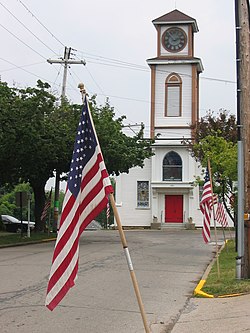Saxonburg, Pennsylvania
| Saxonburg, Pennsylvania | |
|---|---|
| Borough | |

Saxonburg Memorial Church
|
|
| Coordinates: 40°45′15″N 79°48′56″W / 40.75417°N 79.81556°WCoordinates: 40°45′15″N 79°48′56″W / 40.75417°N 79.81556°W | |
| Country | United States |
| State | Pennsylvania |
| County | Butler |
| Settled | 1832 |
| Incorporated | 1846 |
| Government | |
| • Type | Borough Council |
| Area | |
| • Total | 0.9 sq mi (2.3 km2) |
| Population (2010) | |
| • Total | 1,525 |
| • Density | 1,683/sq mi (649.9/km2) |
| Time zone | Eastern (EST) (UTC-5) |
| • Summer (DST) | EDT (UTC-4) |
| Zip code | 16056 |
| Website | www |
Saxonburg is a borough in Butler County and part of the Pittsburgh metropolitan area, in the United States. It was founded in 1832 by John A. Roebling. The city was first named "Germania" and "Sachsenburg" before arriving at its present name. The population was 1,525 as of the 2010 census.
Founded in 1832 by John A. Roebling, who is known for the design of the Brooklyn Bridge in New York and for innovation in producing wire rope, the community was initially called "Germania", which was soon changed to "Sachsenburg" and eventually anglicized to Saxonburg. Roebling had set out with his brother Karl and a group of pioneers from Germany in 1831 to flee the general unrest and oppression in Europe. The two men, along with a handful of the people who accompanied them on the trans-Atlantic journey secured 1,582 acres (6.40 km2) of land on October 28, 1831, from Mrs. Sarah Collins.
In November 1920, KDKA radio, regarded as the world's first commercial radio station, began broadcasting from East Pittsburgh, but later located its transmitter in neighboring Clinton Township. The Roebling Museum in the borough maintains several artifacts.
In 1946, Fred Seitz, then head of the physics department at Carnegie Tech, brought Ed Creutz, Jack Fox, Roger Sutton and Bert Corben to Carnegie Tech to establish an important nuclear physics research program. By June 6, 1946, a leading-edge 450 MeV proton synchrocyclotron was built at the Nuclear Research Center near Saxonburg, just south of the Saxonburg limits. The research program there flourished up to the mid-1970s when the then-obsolete accelerator was dismantled. The site was converted to industrial purposes, and is now occupied by II-VI Corporation. As of 1997, only one or two of the original Nuclear Research Center buildings remained, including the original laboratory building, more or less intact.
...
Wikipedia

